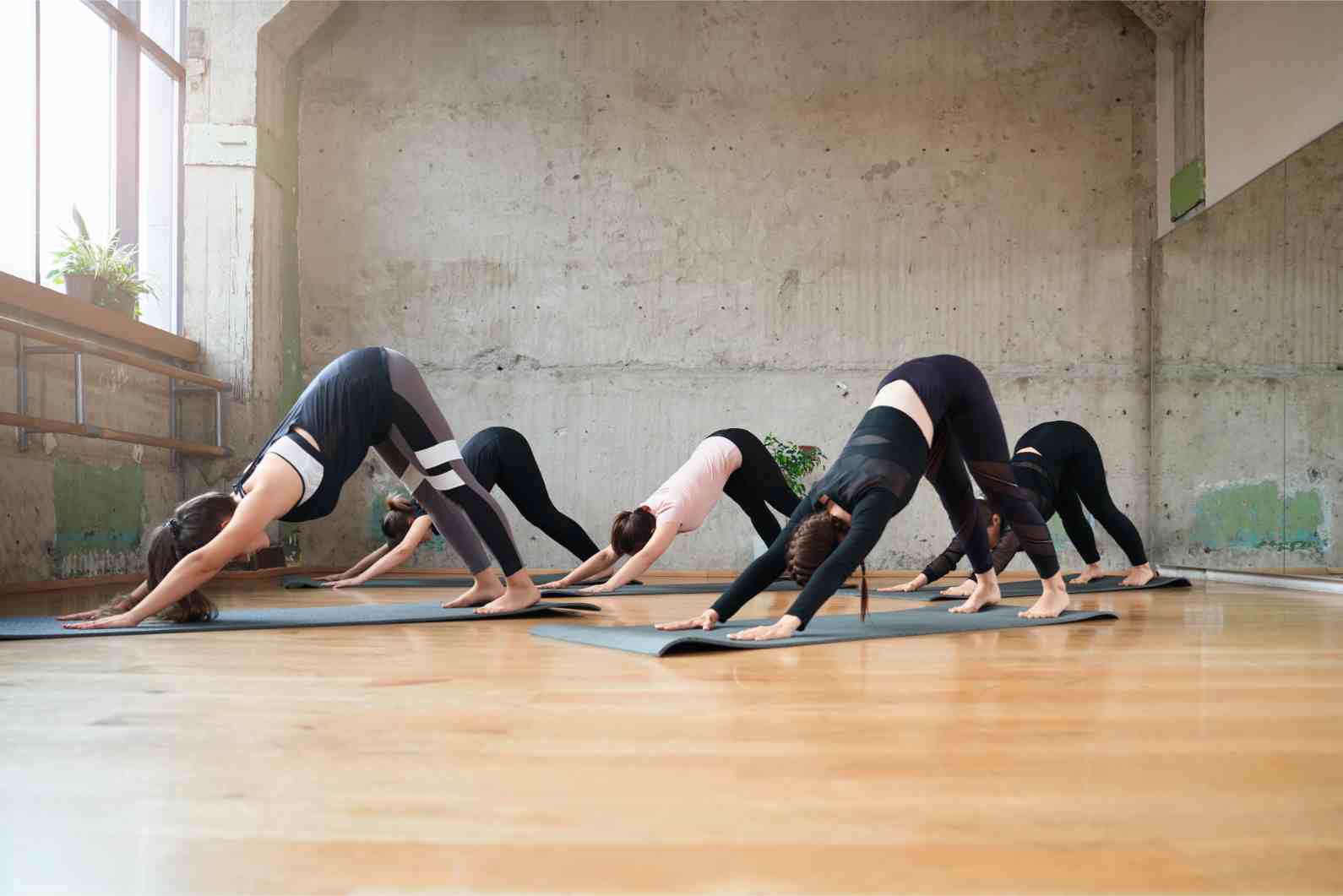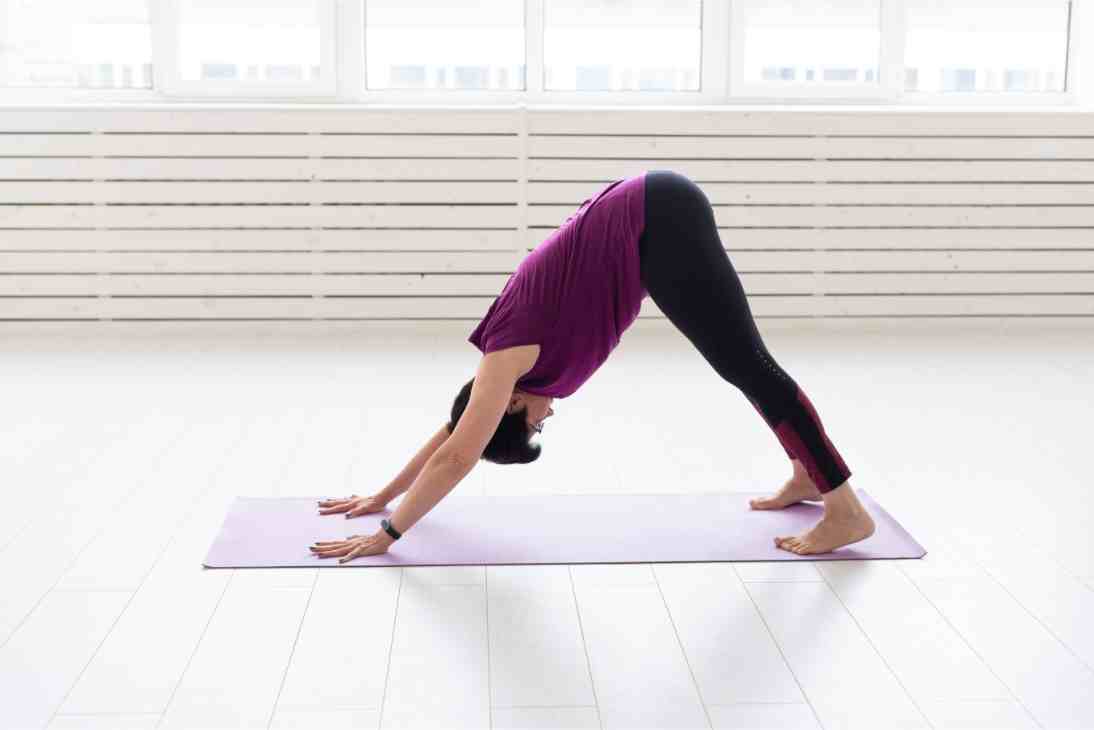How to Perform Downward Dog Pose (Adho Mukha Svanasana) & its Health Benefits

The art of practising yoga daily helps strengthen the mind, body and soul. One of the most popular yoga poses, Adho Mukha Svanasana or the downward dog pose, helps relieve chronic back, shoulder, and arms pain.
Although it may look easy, it is a complex wellness practice. This yoga pose requires a lot of strength. Read the full article to learn about this exercise, its benefits, precautions, and more.

Table of Contents

What is Downward Dog Pose?
Downward dog pose, or Adho Mukha Svanasana, is a popular standing yoga pose that improves blood circulation. 'Adho' means downward, 'Mukha' means face, and 'Svan' means dog. 'S. Additionally, it ensures a full-body stretch, where you have to expand the body on all four limbs. You can perform this yoga pose as a resting (Ashtanga) or a transitional pose (Vinyasa).
Moreover, as this yoga pose involves stretching and strengthening, it will help you gain flexibility and balance physically. However, ensure that you perform and practice this exercise with utmost care. If you have stiff hamstrings or shoulders, this asana can be challenging. You must initially have a trainer guide you through this yogasana.
Yoga Level: Intermediate to Advanced
How to Perform Downward Dog Pose?

Downward dog pose, also known as Adho Mukha Svanasana, is a fundamental yoga pose that stretches and strengthens your entire body. Here's a step-by-step guide:
Step 1: Firstly, come down to your knees and hands, placing your wrists under your shoulders and your knees under your hips.
Step 2: Push back through your hands after curling in your toes. Then, lift your hips and stretch your legs carefully.
Step 3: Spread your fingers and press down against the floor with your palms to exert pressure on your fingertips.
Step 4: Rotate your upper arms outward to help broaden your collar bones.
Step 5: Allow your head to hang. Then, slowly shift your shoulder blades away from the ears and towards the hips.
Step 6: You must firmly engage your quadriceps to remove your body's burden from your arms. This is the resting pose.
Step 7: Keep your tail high, gently place your heels towards the floor, and gently rotate your thighs inward.
Step 8: Make sure that the distance between the hands and your feet is similar in both resting and transitional poses.
Step 9: Slowly exhale and bend your knees, allowing yourself to release and come back to your original posture.
Benefits of Doing Downward Dog Pose Daily
The downward dog pose (Adho Mukha Svanasana) is a foundational yoga pose known for its comprehensive benefits. It stretches and strengthens the body, promoting flexibility, stability, and well-being.
1. Tones Your Lower Abdomen
Since this yoga pose engages your core muscles, it helps tone the lower abdomen. This additionally ensures fat loss from your abdomen. Moreover, it relieves back pain as you use the strength of your arms and legs to stretch your spine evenly.
2. Increases Blood Circulation
This pose helps to stimulate blood flow as it places the heart above your head. It is an inverted ‘V’ position and initiates blood flow to your head. Enhancing your energy and focus, this asana will ensure instant relief from stiff neck pains and painful shoulders.
3. Strengthens Your Bones
Downward dog pose is a weight-bearing yoga pose that helps to strengthen your bones. If you practice downward yoga daily, it will provide strength and balance to your upper body. Therefore, you will be able to manage osteoporosis. In addition, the downward dog position works on your shoulders gentl
4. Stretches the Backside of Your Legs
Apart from your spine, the hamstrings and calf muscles will feel stretched, too. The benefit of Adho Mukha Svanasana is that it opens the backside of your legs as you pull them gradually, providing relief to the back muscles of your legs.
5. Strengthens Your Arms
Since the downward pose initiates strengthening the upper portion of your body, it tones your arms, making them stronger. While performing this pose, you must press your palms against the floor and put pressure on your muscles.
6. Helps to Stretch Your Back
The downward dog poses back pain by stretching the backside. Stretching the spine enhances the oxygen supply to different body parts. You must practice this asana daily to stay stronger.
Other Benefits:
The other benefits of this yogasana are:
This yoga pose pumps oxygenated blood to your body and helps keep cough and cold away.
This yoga pose increases blood flow to your head and supplies nutrients to your hair.
Adho Mukha Svanasana helps fight against indigestion, acidity, and gastric problems.
One significant benefit of downward dog pose is that it affects the pituitary gland, which further maintains insulin levels in the body.
The downward dog pose cures swollen veins, commonly known as varicose veins.
This pose improves your retaining power as well as your memory.
This pose strengthens the smaller tissues in your feet, such as the plantar fascia.
Since blood flows to the brain and face, this boosts the skin's texture, allowing for healthy and glowing skin.
If you have panic attacks, Adho Mukha Svanasana is beneficial for you.
Safety Precautions to Take While Performing Downward Dog Pose
Downward dog pose is a generally safe pose, but there are some precautions to keep in mind:
- Start With Smaller Movements: For beginners, it is recommended to start with smaller movements as they become more accessible and easier. For example, try using yoga blocks as a prop while you stretch your hands. After practising for a few days, this will automatically become easier to perform.
- Modify Your Heel Placement: If you experience difficulty extending your legs while keeping your backside straight, you can modify the placement of your heels. This will cause relief as you can allow your heels to rise off the floor smoothly. When you decide to stretch further, try to move your heels back to the floor.
- Try Using a Chair: This yoga pose can seem strenuous on your body if you have limited flexibility. Instead, use a chair to leverage your arms and help your body to be in a ‘V’ position. You can then carefully place your feet back till you feel the stretch.
- Avoid Locking Your Knees: As you extend your legs while doing the pose, do not extend or stretch your knees more than required. This is to avoid locking your knees, which may lead to straining your joints and injury. Instead, try to keep your legs straight and bend your knees slightly. This will ensure adequate stability and balance.
- Keep Your Back Straight: One of the main benefits of a downward dog pose in yoga is that it strengthens your back. Therefore, avoid bending while performing this exercise. Instead, tilt the pelvis forward so your spine is straight.
- Use Yoga Ropes for Extension: You can use extension ropes if you perform this yoga pose in a gym or studio. These ropes attached to the walls help you stretch while performing specific poses.
What Are the Easy Modifications of a Downward Dog Pose?
Since the downward dog pose is a bit complex, here are the modifications you can do:
- Bend Your Knees: Slightly bend your knees by lifting your tailbone and heels.
- Use Wall as a Prop: By facing the wall, you can bend your hips and maintain a straight spine. Press your hands on the wall.
- Place a Block: If you want to ensure proper alignment in this exercise, you can place a block between your thighs.
- Cushion Under Your Head: To relieve stress on your neck, place a cushion or block under your head.
- Knees On Mat: For a comfortable posture, place your knees on a mat.
So now that you know the downward dog pose, its benefits, and precautions while performing, try doing it with the help of your trainer. This yogasana will benefit you if you face digestion problems or chronic back pains.
Who Should Avoid Practising Downward Dog Pose?
While downward dog pose is a great pose for many, there are some circumstances where it's best to avoid it:
- Individuals with Wrist Injuries: Those with wrist pain or conditions such as carpal tunnel syndrome should avoid the downward dog pose. The significant pressure placed on the wrists in this position can exacerbate pain and injuries. Alternative poses that minimise wrist strain are recommended.
- People with Shoulder Issues: If you have a shoulder injury or severe shoulder tightness, practising downward dog can worsen the condition. The pose demands substantial shoulder strength and flexibility. Modifying or skipping this pose is best to avoid aggravating shoulder problems.
- High Blood Pressure: Individuals with uncontrolled high blood pressure should avoid the downward dog pose. The inverted position can increase blood pressure. Consulting a doctor and choosing poses that do not elevate blood pressure are safer options.
- Eye Conditions: Those with glaucoma or other eye issues should avoid the downward dog pose. The head-down position can increase intraocular pressure, potentially worsening eye conditions. Other poses that keep the head level are preferable for these individuals.
- Ear Infections: Individuals with ear infections may experience discomfort or dizziness due to the inversion in the downward dog pose. The change in pressure can exacerbate symptoms. Until the infection is resolved, it's best to avoid this pose.
- Late Pregnancy: Pregnant women, especially in the later stages, should consult their healthcare provider before practising the downward dog pose. As the pregnancy progresses, the pose may become uncomfortable or unsafe. Modifications or alternative poses are advisable.
- Back or Neck Problems: Those with severe back or neck injuries should avoid the downward dog pose or modify it under the guidance of a qualified instructor. The position can place strain on these areas, potentially worsening existing issues. Proper adjustments ensure a safer practice.
Incorporating the downward dog pose into your routine can significantly enhance your health and well-being. This foundational yoga pose promotes flexibility, strengthens muscles, and improves circulation, making it an excellent addition to any fitness regimen. Regular practice can alleviate stress, enhance mental clarity, and support cardiovascular health.













